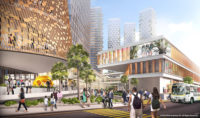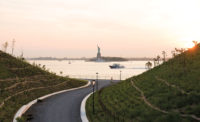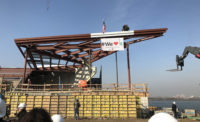For the 12 million immigrants who passed through Ellis Island between 1892 and 1954, the sight of the Statue of Liberty presiding over New York Harbor signified their hard-won arrival in the land of the free. Today, 120 years after the French presented this gift to the United States, the statue’s symbolism still endures, though it attracts pilgrims of a different kind—some 4 million tourists each year.
For present-day sightseers, access to Lady Liberty is highly restricted. Climbs to her crown—designed by Frédéric Auguste Bartholdi, and built by Gustave Eiffel—must be reserved as much as six months in advance; for the museum, housed within the Richard Morris Hunt–designed pedestal, only 20 percent of all visitors are even allowed access, due to post-9/11 security concerns. Everyone else is left to wander the 12-acre island’s uninspired grounds (“free audio tours add to their experience,” the website assures), snap a selfie, and catch a boat back to Manhattan.
A new initiative, spearheaded by the Statue of Liberty-Ellis Island Foundation and the National Park Service (NPS), is looking to change that. On October 6, officials broke ground on a new museum, a 26,000-square-foot facility at the island’s northwest edge, designed by FXFOWLE.
“Only a small number of people get to experience the whole thing when they’re here,” said firm partner Nicholas Garrison at the event. “We wanted to add to this island a joyous new place that could be experienced by everyone, regardless of age, language spoken, or type of admission ticket.”
The FXFOWLE design, which features an exterior stair leading to a landscaped roof, seems to grow out of the island itself, as if a corner of the lawn has been peeled away. Its materials are also an extension of the island, a fusion of stony creek granite (the same used by Hunt for Lady Liberty’s base), precast concrete, copper-zinc alloy, and bronze.
One of the primary drivers of this scheme, according to Garrison, was storm resiliency. During Hurricane Sandy, more than 75 percent of the island was flooded. The roof stairway in the FXFOWLE plan means the base level of the museum will be “over the 500-year storm surge, with some belts and suspenders,” Garrison said.
The generous interior spaces, meanwhile, were designed to accommodate Lady Liberty’s original 18-foot-tall torch (currently housed in the statue’s base), and the throngs of visitors expected when the museum is finished—nearly 450 every half hour at peak times, according to Garrison. The firm ESI Design worked with FXFOWLE to devise a series of flowing interior exhibition spaces, which will include an immersive theater and interactive exhibits detailing the Statue’s history and construction, and current perceptions of the meaning of liberty. The exhibition will culminate with a glazed gallery containing the torch, set against scenic views of the statue.
Construction is set to wrap up in 2019, according to the Foundation and NPS.
But freedom isn’t free: the new museum will cost an estimated $70 million. To raise such a sum, the Foundation enlisted an unlikely “godmother” for the island’s beautification— the fashion designer Diane von Furstenberg. Just as newspaperman Joseph Pulitzer petitioned the public to raise money for the Statue’s pedestal in 1885, von Furstenberg is in charge of fundraising efforts. (“Thanks to my husband [Barry Diller] I usually sign the check and get it over with,” she said.)
Von Furstenberg came up with an idea for a donor sculpture, spangled with 50 stars made from the original armatures by Eiffel that supported Liberty’s internal structure. Stars were offered to potential donors for $2 million each. The idea worked: individuals and organizations including Jeff Bezos, Michael Bloomberg, Coca- Cola, George Lucas and Mellody Hobson, and even Chanel (“French, made sense,” said von Furstenberg) donated.
New York Mayor Bill de Blasio, himself a descendant of Italian immigrants, lauded the museum at the groundbreaking. “My hope for this great museum is that it will be one of those bridges that helps us to finally come to peace with the fullness of who we are, the complexity of who we are, and the beauty of who we are,” he said.












Post a comment to this article
Report Abusive Comment